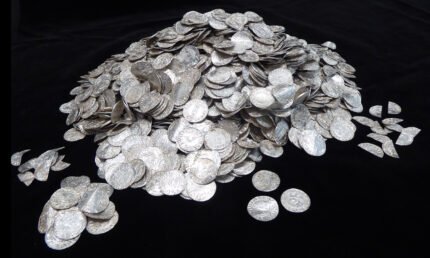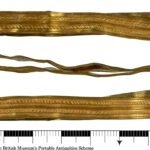 The hoard of 2,584 silver pennies from the time of the Norman conquest discovered at Chew Valley in Somerset has been acquired for the nation by the non-profit South West Heritage Trust. Valued at £4.3 million ($5.6 million), it is the highest-value treasure find ever made in England. The organization was able to raise the money thanks to a large grant of £4,420,527 from the National Lottery Heritage Fund and £150,000 from the Art Fund. The sum will be shared 50/50 between the landowner and the seven finders.
The hoard of 2,584 silver pennies from the time of the Norman conquest discovered at Chew Valley in Somerset has been acquired for the nation by the non-profit South West Heritage Trust. Valued at £4.3 million ($5.6 million), it is the highest-value treasure find ever made in England. The organization was able to raise the money thanks to a large grant of £4,420,527 from the National Lottery Heritage Fund and £150,000 from the Art Fund. The sum will be shared 50/50 between the landowner and the seven finders.
The coins were discovered by a group of seven metal detectorists in January of 2019. Only two of them, Lisa Grace and Adam Staples, were experienced, and they were teaching the rest how to use their new machines when one of the newbies found a William the Conqueror silver penny. Then they found another, and another. They should have stopped after the first few coins and called archaeologists, of course, but they did not. Instead, five hours of detector alerts and amateur digging later, they had a bucket full of thousands of silver coins. Only then did they report the find to the Portable Antiquities Scheme and a week later they deposited the coins at the British Museum.
The coins had been scattered by agricultural work over the centuries, so the hoard was not found as it was buried anyway, but having lost the chance to excavate the archaeological context of the hoard whatever that might be is all the more tragic in this case because the hoard is unique window into the immediate aftermath of the Norman invasion. The Chew Valley hoard consists of 1,343 silver pennies of William the Conqueror (r. 1066-1087), and 1,240 coins from the last Anglo-Saxon king of England Harold II (r. January 1066-October 14 1066), with a one penny of Edward the Confessor (r. 1042- January 1066) and three “mules,” counterfeit combinations of coins by William and Harold that were created by moneyers to dodge taxes. About 100 moneyers from 46 mints are named on the coins; some of the moneyers are the first named people from an English city.
All of the coins date to between 1066 and 1068. It is the largest hoard of coins from the immediate post-Norman Conquest period ever discovered and the largest Norman treasure of any kind to be found since 1833. The hoard was buried in 1068 on a property that would later be granted to Gisa, chaplain to King Edward the Confessor and the Bishop of Wells. At that time, the Chew Valley was embroiled in a rebellion against Normal rule led by Harold’s sons, so it’s like the coins were buried for safekeeping.
The Chew Valley hoard will go on display at the British Museum starting November 26th. It will then go on a brief tour of UK museums, including in Bath near the find site, before settling permanently at the Museum of Somerset in Taunton.







